Soviet military theory of breaking through enemy defenses on the eve of World War II
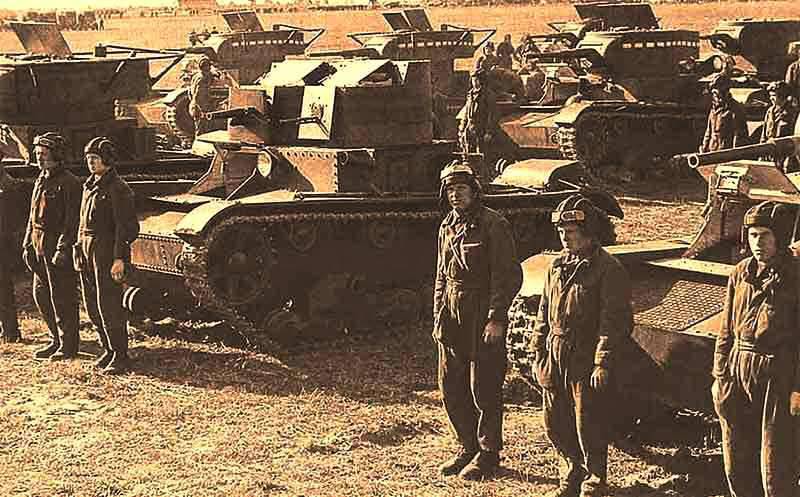
The problems of a breakthrough of defense that arose during the First World War, and then in the 20s and 30s, became the center of attention of world and national military science. The result of their solution was the theory of a deep operation, the main provisions of which were subjected to serious verification at a number of exercises of 1937-1938, which revealed some of its shortcomings. In particular, the simultaneous actions of three echelons tanks initially reduced the strength of the initial strike.
In the thirties, military theorists considered it necessary to use tanks in exactly three echelons and even divided them into three categories:
- long-range tanks (DD), which were intended to break into the depths of the enemy defense with the support of infantry units, as it was foreseen by the theory of deep combat and deep operations. DD tanks were to destroy the main artillery positions of the enemy, smash tactical and operational headquarters and reserves, cut off the enemy’s main forces of the withdrawal path;
- long-distance support tanks (DPP) were intended to suppress mortar and artillery fire to a depth of 2 km in front of the advancing motorized riflemen;
- tanks of direct infantry support (RPE) were to accompany the infantry in the attack. Indulged in small units.
With the actions of long-range tanks in isolation from the next two echelons and infantry, the task of breaking through into the area of firing positions of enemy artillery turned out to be difficult. The use of echelon tanks in a breakthrough made the interaction too complicated, because the artillery, having ensured the attack of the DD tanks, had to switch to support the attack of the SPE tanks and infantry.
Military conflicts with Japan on the Far Eastern borders, and then on the Khalkhin Gol River, the campaign of the German army 1939-1940, the fighting of the Red Army in a military confrontation with Finland gave a wealth of material for generalizations and the development of theoretical positions and recommendations that largely meet the prevailing conditions armed struggle.
After a meeting of government leaders with the highest command of the armed forces in April 1940, which raised questions of increasing the combat effectiveness of troops and fleet, the Red Army launched research work on the generalization of combat experience and the use of new equipment, which began to enter the troops widely. Its result was the publication of a number of monographs, numerous articles, and several draft field and combat manuals. In particular, in the prewar years such works as “New forms of struggle” appeared by G.S. Isserson (1940), “Breakthrough of the fortified strip” P.S. Smirnova (1941), textbooks “General Tactics”, “Tactics of Tank Forces”, “Tactics of Artillery” and many others.
The central issue of these works was the breakthrough of the prepared enemy defense. He was also given a prominent place in speeches at a meeting of senior military leadership held in December 1940. G.K. During the report at this meeting, Zhukov defined the nature of the offensive operations and the role of the breakthrough in them: “... it is legitimate to expect that the initial initial operations are likely to begin with frontal attacks. The problem of the offensive will be to first break through the front of the enemy, form the flanks, and then, in the second phase, proceed to broad maneuver actions. ”
This provision correctly enough took into account the folding conditions of warfare. Our most likely enemy, fascist Germany, had deployed about 156 divisions by the end of the campaign in France. In preparation for the war with our country, she began to form more 58 divisions. In addition, a significant number of connections agreed to put the satellites. This amount was enough to create powerful strike forces, to block the entire strategic front from sea to sea and, thus, to avoid bypassing positions and groups. And this meant that, by taking retaliatory actions, the Red Army troops would have been forced to make a breakthrough in order to open for themselves the path to broad maneuver actions.
At the same time, the following point of view was also expressed at the meeting: an offensive could begin with a breakthrough of reinforced concrete fortifications, which already encircle the borders of large states. It cannot be considered true, since the fortified lines of the fascist German army and its allies were only on the flanks — in East Prussia and Romania.
The theory of deep operations, which was the basis for new research, made it possible to find the right solutions to the fundamental issues of the difficult problem of breaking through enemy defenses. According to the opinion established before the war, a breakthrough could be used to create a gap in the previously prepared and hastily created defense, as well as in a fortified area. It was believed that the breakthrough of the enemy defense front should take place during the conduct of a frontal offensive operation. In this case, the front of the union could inflict several army strikes, one of them - the main one.
The army could make a breakthrough in one direction, in the center or on the flank of its operational construction, as well as in two or three directions, while striking either frontal or converging with the aim of dissecting or surrounding a certain enemy grouping.
An operational breakthrough was considered one that excluded the interaction of the combined-arms formations remaining on the flanks of the torn front, ensured the introduction of a mobile group into battle, and also led the advancing troops to the operational space. For the army, a breakthrough width of 20-30 km was considered the most appropriate, the minimum width was set at 16 km. In determining this value, the following was based on the following: such a breach cannot be shot through the enemy’s artillery from the flanks; light enemy artillery loses the ability to conduct aimed fire at the columns of the mobile group when entering it into a breakthrough; the 20-30 km wide breach cannot be securely closed by the enemy’s immediate operational reserves.
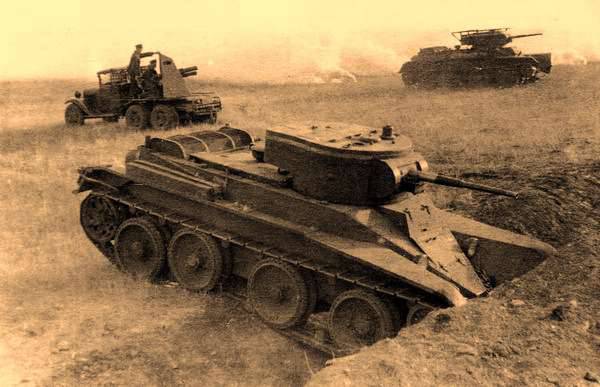
For the front, which inflicted several blows, the total width of the breakthrough sections could reach 80-100 km. The operational breakthrough was considered completed when the troops reached the depth of 30-70 km, i.e., they broke through the tactical zone of defense and the defense zone of the army reserves. Its implementation in one direction was entrusted to a combined-arms, usually shock army, or two armies that struck on adjacent flanks. The composition of the main group of the shock army was recommended to include three or four rifle corps concentrated in the area constituting 20-50% of the width of the advance of the armies.
Along with the main thing in the army, it was recommended to deliver an auxiliary strike of such strength, so that they could break through the tactical defense and thereby draw upon themselves some of the forces of the defending enemy. Comparison of these very important breakthrough regulatory categories with the experience of the Great Patriotic War showed that they were close to the most common in many offensive operations related to the breakthrough of prepared defense.
In order to break into the defenses with fire, according to the views of the thirties, it was considered sufficient to have 50-100 guns at one kilometer of the breakout area. During the artillery training during the 1-3 hours they had to release about two combat sets of shells. The experience of the war showed that the degree of enemy fire destruction provided for by the prewar theory was achieved only in 1943 operations of the year, in which, although density was created in 100-150 and more artillery guns and mortars at one kilometer of the breakthrough section, the expenditure of projectiles was not a third less. This suggests that before the war, the density of fire destruction were correctly identified for the breakthrough of the field defense, equipped to a depth of 3-4 km, as well as the defense prepared in a limited time.
It should be noted, however, that due to the qualitative changes in the artillery combat composition in 1941, when 76-122-mm guns and 82-mm mortars became prevailing, such densities were often clearly insufficient.
Artillery support, in pre-war views, besides artillery preparation, included fire support. Further, the artillery aimed at the task of securing the entry of second echelons into the battle and repelling counterattacks, at holding back the rear fire and obstructing the approach of reserves.
During the artillery preparation, there was a tendency to influence fire on the entire tactical depth of defense, but most strongly - in the first position. The desire to suppress all positional defense did not correspond to the capabilities of artillery groups created according to the regulations. This task became to some extent feasible only with the density of 250 and more artillery systems on 1 km, of which at least 60% were large calibers. Artillery preparation included at least two 10 minutes of fire attacks each, methodical fire, repeated two or three times 10-15 minutes, one or two false fire transfers.
If a period of destruction was envisaged from closed positions, then about half of the artillery preparation time was allotted to it. Special time for direct fire has not yet been allocated, although during the Winter War in 1940, it found quite widespread use. Attack support was provided for a depth of 1-1,5 km. Its task was to prevent the enemy with the beginning of the attack to restore the broken system of fire, to provide a throw in the attack of the shooters and tanks, they capture the front edge and the development of the attack in depth. Support methods - fire shaft, sequential concentration of fire (PSO) and a combination of these two types of fire. Further, in the performance of fire missions, artillery used concentrated, massive, and barrage fire at the request of the combined-arms commanders. In general, the enemy’s artillery fire engagement met the requirements of the conduct of hostilities of that period and was widely used in the operations of the Second World War.
Tasks for breaking the enemy’s defense were also assigned to Aviation. It is worth noting that in the prewar years the struggle between the two trends intensified. At the heart of one, born of the "Spanish" experience, was the use of aviation only on the battlefield, while the other - beyond the limits of defeating the enemy by artillery fire. There was even an opinion that striking on the battlefield with attack aircraft was not practical. The first trend was gaining more and more. And therefore, in the Field Code of 1941 it was written that contributing to the success of the ground forces in battle is the most important task of aviation. During the breakthrough, it was supposed to hit deep-seated targets, contribute to the development of success, and protect troops from enemy air strikes.
Although a reliable hacking of the enemy’s defenses with fire is one of the most important prerequisites for its successful breakthrough, infantry and tanks continue to breach it with the continuous support of their advance by artillery and aircraft. The breakthrough of the main line of defense was assigned to the divisions and corps of the first echelon of the army, which was their immediate task. The breakthrough of the second band could be carried out by rifle divisions and corps. In the course of these actions, the width of the offensive corps in the direction of the main strike was provided for 7-12 km, and for the binding one - 15-18 km. In the event of an attack on a heavily fortified defense, the division was cut into a 2-3 km wide strip. When attacking an insufficiently fortified defense, its strip expanded to 3-3,5 km. To complete a tactical breakthrough, a mobile army group (mechanized corps) could be introduced into battle. One of its tasks was to capture the second defensive line before the enemy managed to organize a defense on it.
For the breakthrough of defense to the operational depth and its expansion towards the flanks, the use of second echelons and reserves of armies, as well as a mobile front group, was allowed. Depending on the strength of the defense, a breakthrough could begin with an approach and from direct contact with the enemy. It was recommended that the organization of a breakthrough should be spent on: hastily organized defense - 6-8 hours, on medium fortified - 1-2 days, on strongly fortified - from two or more days.
Divisions, reaching in the first echelon, built battle formation, usually in two echelons, corps for the most part - in one. Artillery groups were also envisaged in combat divisions: infantry support — by the number of regiments, long-range, and, in addition, a combined-arms and tank reserve. The corps also created a combined-arms and tank reserve and a long-range artillery group.
The shock army for breakthrough was built in two echelons. In the first, on the main line, it was recommended to have two or three rifle corps, and on the auxiliary one. In the following - the mobile group and the rifle corps.
The operational construction of the front included the first echelon, consisting of two to five shock and two to four chilling armies, the second included a horse-mechanized army (group) and a general reserve, or reserve army.
In connection with the deployment in 1940-1941. A large number of mechanized corps, formed from many separate battalions and brigades, made it difficult to create a train of direct infantry support tanks. The reason was that for this, tank units stood out from mechanized corps, the nature of their combat training was different than that required by the action of tanks during a breakthrough in cooperation with rifle subunits. It was recommended to create a train of SPE tanks at the rate of one tank company per rifle battalion. To strengthen the infantry division required two or three tank battalions. This made it possible to bring the density of NNP tanks to 30 armored vehicles for one kilometer of the breakthrough section. In addition, reserves of the divisions and corps were formed from one to three tank battalions. And this means that in the army about one tank division needed to be allocated to create a train of SPE. Echelon tanks NPC was built in two or three lines with distances between them 100-200 m, with the first line were heavy and medium tanks at the rate of 10 on 1 km of front.
The density of troops recommended by the Soviet prewar theory was quite high. In conditions of concentrating the efforts of the shock armies on one section of the breakthrough, they allowed to create a three-, five-fold superiority over the enemy. But since the main and auxiliary strikes were foreseen in the army, the superiority was reduced to twofold, which was then considered sufficient for a breakthrough. However, such an advantage of forces rarely led to a successful breakthrough and by the end of the war it increased threefold and more.
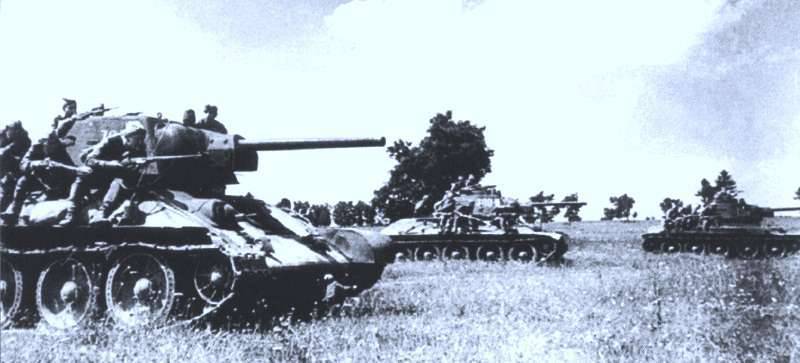
The occupation of the initial position depended on the method of going on the offensive. When the approach was preceded by a breakthrough, the troops committed it in columns or dismembered formations (in the pre-battle formations), having the advance guard ahead. If the avant-gardes managed to penetrate the enemy defense, which was not sufficiently stable, the main forces could launch an offensive on the move. When attacking a fairly solid defense, the troops were first led to areas of concentration, remote from the front edge, at a distance from 3 to 5 km, and only from there did the rapprochement, the attack and the attack take place.
In the event of an offensive after direct contact with the enemy, a regrouping was carried out, and the initial position was occupied during the change of troops that had previously been in contact with it. The beginning of the attack was recommended to be planned in such a way that during the day it was possible to overcome the main line of defense and capture the second one or go to it if it turned out to be occupied in advance.
During the breakthrough preparation period, the attacking troops, usually at night or during the artillery preparation, were to take the starting line further than 300 m from the front edge of the defense line. On it the infantry was digging in and preparing to repel counterattacks.
The troops went over to the attack at the end of the artillery preparation. At the same time, the movement from the initial position had to begin in such a way that the infantry reached the line of attack by the beginning of the last artillery fire attack. During the war, it turned out that the delay at the turn of the attack was undesirable, because it allowed the enemy to prepare for shooting, hit the advancing infantry and thereby thwart the attack.
After overcoming the front edge of the defense, the advancing infantry and tanks, supported by artillery and aviation fire, must continually advance, using each breach to further develop success. For this purpose, second echelons and reserves were introduced into the battle - by shallows or from the flanks of the first echelon, and at a depth of one and a half kilometers a tank reserve could even be entered. The main object of his attack was considered the artillery of the enemy.
After overcoming the main defensive zone, the corps commander immediately had to organize a second breakthrough. For this, it was recommended to send forward detachments consisting of motorized infantry, armored vehicles and artillery. To ensure the development of a tactical breakthrough in the operational, mobile army groups were also introduced. According to the theoretical provisions of 1936-1937. the mobile group could be introduced both before the second lane of the enemy defense, and after its breakthrough.
The mobile group in the mechanized corps was recommended to be introduced into the breakthrough in the 10-12 km band. This made it possible to conduct columns at a distance of 5-9 km from the opened flanks of the enemy and thus make it difficult to conduct real fire with his light artillery.
Ahead of the columns of the main forces of armored divisions were sent out reconnaissance and forward detachments, which since the main line of defense broke through, rushed to the second, with the task of capturing sections on it and identifying a system of fire and fortifications. On the basis of their data, the commander of the mechanized corps specified the tasks for the divisions.
The breakthrough of the second band by mechanized compounds was recommended to be taken on the move. If she practiced well, and the troops approached her shortly before dark, her attack could be postponed for the morning. The nature of the actions of the troops during the attack on the second lane was similar to that of the first. Neither the charter, nor textbooks, nor tutorials gave detailed recommendations.
As for the actions of the troops during the development of a tactical breakthrough into operational, the textbooks only indicated the conditions under which military actions of mechanized and tank formations can take place in the enemy’s operational depth (apart from their troops and in the tactical environment of individual units). The possible tasks were determined: to close the ring of encirclement, to crush the nearest operational reserves or to impede the approach of deeper reserves, to seize the rear army frontier.
The main methods for accomplishing these combat missions were considered: a maneuver for getting closer to the enemy’s reserves or for intercepting the escape routes of his main group; maneuvering to bypass obstacles and well-occupied defense sites; head-to-head combat with suitable operational reserves; offensive battle, if the enemy hastily turned to defense on a broad front line.
The theory of an offensive operation did not at all consider the development of an operational breakthrough into a strategic one. When conducting military games and tactical exercises, the main attention was also paid to the implementation of a tactical breakthrough. With regard to the development of his operational, it is often limited to the entry into the battle of mobile groups. The actions of connections and parts in the operational depth were mainly worked out on maps.
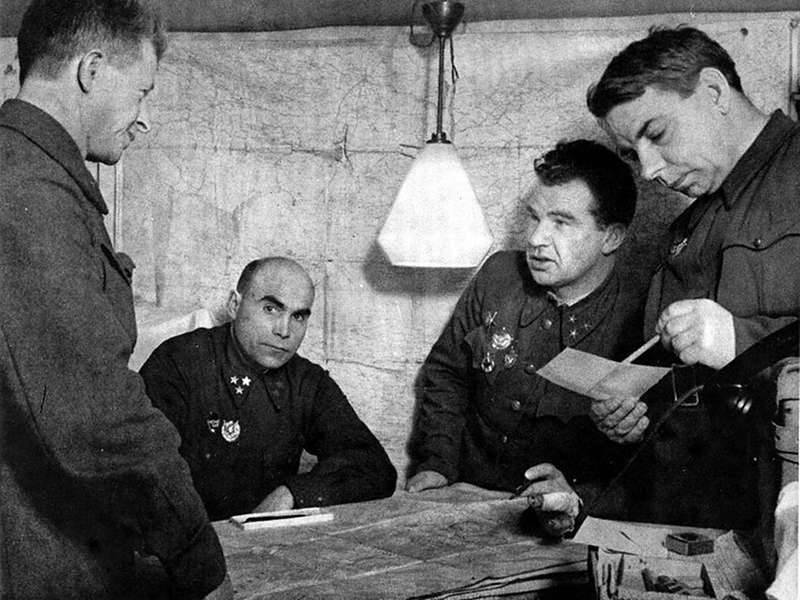
An analysis of the views on the breakthrough of the prepared defense shows that they basically met the prevailing conditions of warfare, and most of them were used in the operations of the Patriotic War. Existing deficiencies under somewhat different conditions of the beginning of the war could be quickly corrected and brought into compliance with the prevailing conditions of military operations. However, this process was delayed. The reason was that the new provisions were not legalized by the charter, which in the form of a draft was issued at the beginning of the war; by that time, the conditions of the armed struggle for our army were much harder than they were supposed to be. Therefore, the troops studied and acted on the basis of the Provisional Field Charter 1936 of the year. The new provisions, set out in the guidelines of the People's Commissariat of Defense and textbooks, managed to study a relatively narrow circle of commanders and staffs, and very few people mastered them while driving troops in training exercises.
The second reason was that the deployment of a large number of compounds was carried out mainly due to the registration structure, which was trained on the basis of the territorial training system. This composition did not possess the knowledge that would allow it to quickly assimilate new forms of warfare. Finally, in 1941-1942. the material basis of the battle and operation changed, which required other recommendations and provisions. It became equal to the pre-war one in about 1943, when it became possible to introduce much of the previous theory into the practice of making a breakthrough and develop it further on the basis of the rich experience of the Great Patriotic War.
Sources:
A group of authors. Soviet military theory on the eve of World War II // History World War II. 1939 — 1945. T. 2. M .: Voenizdat, 1973. C. 187-221.
Zakharov M. The General Staff in the prewar years. M .: Voenizdat, 1989. C.87-96.
Sheptura V. Influence of the theory of deep operation and deep battle on the eve of the Great Patriotic War // Military-Historical Journal. 2006. No.7. C.28-34.
Naumov N. The Theory of Breakthrough of the Enemy's Defense in the Pre-War Years // VIZH. 1971. No.5. C.57-62.
Matsulenko V. Pre-war views on the conduct of an offensive battle // Military history magazine. 1968. No.2. C.28-46.
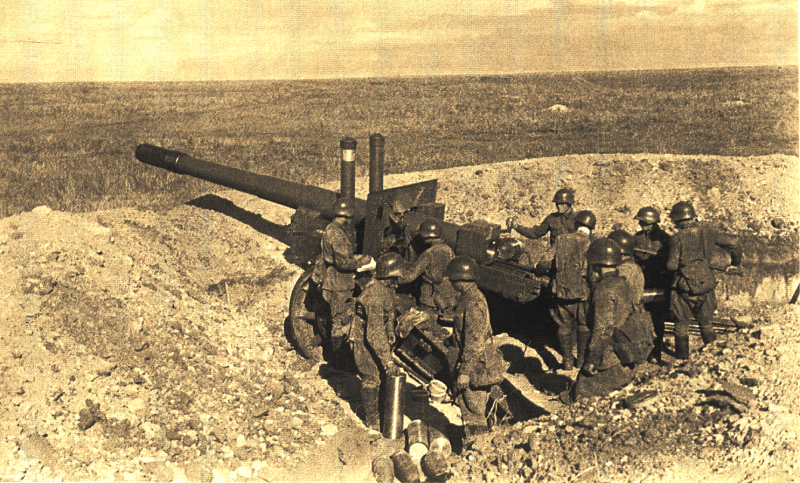
Information